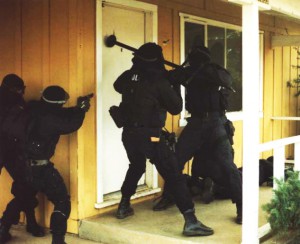The Emergence of No-Knock Raids
The Fourth Amendment was founded on the premise that citizens have an inherent right against unreasonable search and seizures as well as an expectation of privacy. The police are required to obtain a warrant before entering a private home. Additionally, prior to the 1970’s and before the “war on drugs,” they were expected to knock, announce themselves, and wait a reasonable amount of time to give the person a chance to respond.

- A determination that the situation is too dangerous to knock and announce their presence.
- The suspect would have more time to dispose of a weapon or evidence of a crime.
However, it is not often that a judge denies a no-knock warrant (only about 3% of the time) and 10% of the time judges will issue a no-knock warrant, even if the police asked for a standard warrant. It is important to note that the police are not always required to obtain a special warrant. If they “reasonably believe” there is justification to enter the home without knocking, they are entitle to do so. Consequently, the line has blurred between a justified and unjustified no-knock raid. As such, many critics believe the practice continues to be abused, and again subject only to subjective police discretion.
How No-Knock Raids Have Changed 4th Amendment Protections
Most states have provisions in their laws allowing a homeowner to kill an intruder if they reasonably believe the intruder intends to inflict serious bodily harm or death upon an occupant of the home. There are currently 26 states that go even further and allow “Stand-Your-Ground” laws, which permits a person to shoot outside the home if they feel threatened. An example that is widely known is the George Zimmerman case.
As controversial as these laws are, when an intruder breaks into a home, dressed in black, holding a weapon and screaming, many people will choose to shoot, with the intent to kill and will not be prosecuted. However, these laws will not protect a person if they mistakenly shoot a police officer who is breaking into a house as part of a SWAT operation, even if the homeowner reasonably believes the police officer is an armed intruder (especially if the homeowner has a record). Recently there have been instances of this scenario in the media, with over 20,000 no-knock raids in America each year. However, the outcome of attempted prosecution has varied, many blaming a bias based on race. Below are two such examples that are ripe with controversy.
Texas Cases with Drastically Different Outcomes
In 2013, in the pre-dawn hours, a SWAT team entered Henry Magee’s home through the door, without announcing their presence. Henry had previous arrests on possession of marijuana, as well as a DUI. It is important to note that the police did discover marijuana plants in the home. Magee shot and killed one of the officers and was charged with capital murder. However, he argued that he believed the intruders were entering his home and, in order to protect his pregnant girlfriend, he was entitled to shoot. Consequently, the charges never made it past a grand jury indictment and were dropped. Magee is Caucasian.
Five months later, Marvin Guy, who is black, also killed an officer in a no-knock raid, in almost the exact same circumstances. Although Guy had been convicted of more serious crimes than Magee (robbery and weapons charges), the police entered Guy’s home through a window and found nothing that suggested a crime had taken place. In fact, an ACLU study found that 36% of raids fail to produce evidence of a crime and, in 2003, 10% of 450 raids were wrong-door raids. This variation in circumstances from Magee seems to suggest that Guy was more justified in the shooting. However, the grand jury chose to indict and he now faces the death penalty.
Many argue that these raids, targeted to those suspected of a crime, actually endangers innocent persons within the home. Additionally, statistics show that there has been significant differences involving people of color.
The Consequences of No-Knock Raids
Unfortunately, there often times are no consequences for the police or the subsequent prosecution. The exclusionary rule is supposed to be designed to prevent police from using evidence that was obtained illegally. However, recently the courts have not applied this rule to evidence obtained in an unjustified no-knock raid, if that evidence could have been obtained with a standard warrant.
However, there are certainly consequences for the subject of a no-knock raid. Civilian deaths greatly outweigh police deaths in no-knock raids and, even if a police officer is killed, the suspect is very likely to face a charge of murder, despite a valid claim of self-defense.
Additionally, if an innocent civilian is killed in the raid, it is rare that the police are charged with murder, or even civilly liable. In 2010, a Detroit SWAT team killed 7 year old Aiyana Stanley-Jones as she was sleeping as the bullet pierced her brain. In another case, police in Georgia, killed a 19-month-year-old when they threw a grenade into his crib. Neither officer was convicted of the deaths, mostly due to the argument that there was insufficient evidence the police knew the children were in this house. Compare this with Guy’s argument that he did not know that the police were the intruders.
Overall, no-knock raids are a concern across party lines, eliciting outrage from conservatives, libertarians and liberals alike. SWAT raids affect people of color at a staggering 71%. However, studies have shown that Caucasians are often involved in crimes that are more serious, such as hostage situations. Inevitably, the debate will continue to dominate the media when considering constitutional rights, racial bias and the abuse of police power.
